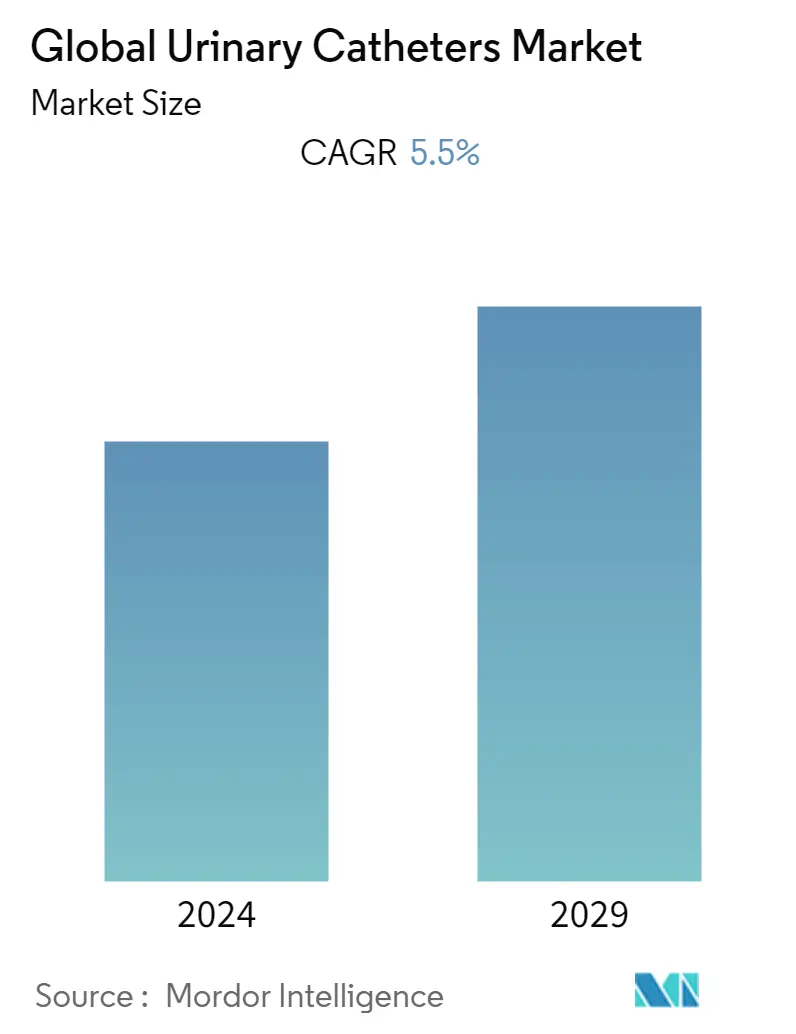Market Size of Global Urinary Catheters Industry

| Study Period | 2019 - 2029 |
| Base Year For Estimation | 2023 |
| CAGR | 5.50 % |
| Fastest Growing Market | Asia Pacific |
| Largest Market | North America |
| Market Concentration | Medium |
Major Players
*Disclaimer: Major Players sorted in no particular order |
Urinary Catheters Market Analysis
The urinary catheters market is expected to register a CAGR of nearly 5.5% during the forecast period of 2022-2027.
A profound impact on the urinary catheter market is expected due to the COVID-19 scenario. As the number of cases is still on the rise, the demand for urinary catheters is also expected to increase since urinary catheters are used in some critically ill patients suffering from COVID-19. Thus, this is expected to impact the demand for urinary catheters positively.
The primary factors driving the growth of the urinary catheter market include the rising prevalence of urinary incontinence, the growing geriatric population, and technological advancement in the material used for catheters.
Increasing funding provides support for more innovative product launches in the market. For instance, in December 2020, Ingenion Medical Ltd received about GBP 100,000 funding from the Innovative UK to develop its product CymActive urinary catheter. It is a novel medical device that is designed for treating male patients suffering from urinary retention. Urinary incontinence is an underdiagnosed and underreported condition that is likely to increase with age and majorly affects the elderly population. Furthermore, as per the World Ageing Population report, in 2019, about 702.9 million people living were aged 65 years and above, and this number is expected to reach 1,548.9 million by 2050. Thus, this is expected to fuel the market growth.
Urinary Catheters Industry Segmentation
As per the scope of the report, urinary catheters refer to a long hollow flexible tube needed for emptying the bladder and collecting the urine in a drainage bag. The material of the tube can be rubber, plastic, or silicone. If the bladder is not emptied, pressure is created in the kidney tissues, which, under severe conditions, may lead to kidney failure. The urinary catheters market is segmented by product type (indwelling (foley) catheters, intermittent catheters, external catheters), application (benign prostate hyperplasia (BPH), urinary incontinence, spinal cord injury, and other applications), and geography (North America, Europe, Asia Pacific, Middle-East and Africa, and South America). The market report also covers the estimated market sizes and trends for 17 different countries across major regions globally. The report offers the value (in USD million) for the above segments.
| By Product Type | |
| Indwelling (Foley) Catheters | |
| Intermittent Catheters | |
| External Catheters |
| By Application | |
| Benign Prostate Hyperplasia (BPH) | |
| Urinary Incontinence | |
| Spinal Cord Injury | |
| Other Applications |
| By Geography | ||||||||
| ||||||||
| ||||||||
| ||||||||
| ||||||||
|
Global Urinary Catheters Market Size Summary
The urinary catheters market is poised for significant growth, driven by factors such as the increasing prevalence of urinary incontinence, a burgeoning geriatric population, and advancements in catheter technology. The COVID-19 pandemic has further influenced market dynamics, as urinary catheters are essential for critically ill patients, thereby boosting demand. The market is also witnessing increased funding for innovative product development, exemplified by Ingenion Medical Ltd's efforts to create novel devices for urinary retention. The growing incidence of benign prostate hyperplasia (BPH) among older men is expected to contribute to market expansion, despite some delays in diagnosis and treatment due to the pandemic. This condition often coexists with urinary incontinence, exacerbating the market's growth trajectory.
Regionally, North America holds a significant share of the urinary catheter market, with expectations of continued dominance. The region's market is bolstered by the rising incidence of urinary incontinence and an aging population, alongside the introduction of technologically advanced products like the TempSensor catheter. The market is moderately fragmented, with a few major players such as B Braun Melsungen AG, Boston Scientific Corporation, Teleflex Inc., and Medtronic PLC leading the charge. These companies are heavily invested in research and development to innovate and enhance product offerings. The introduction of new products, such as CATHETRIX's catheter stabilizer and UroDev Medical's IntelliFlow Bladder Management System, underscores the competitive landscape and the ongoing efforts to address challenges like urinary tract infections and catheter management.
Global Urinary Catheters Market Size - Table of Contents
-
1. MARKET DYNAMICS
-
1.1 Market Overview
-
1.2 Market Drivers
-
1.2.1 Rising Prevalence of Urinary Incontinence
-
1.2.2 Growing Geriatric Population
-
1.2.3 Technological Advancement in the Material Used for Catheters
-
-
1.3 Market Restraints
-
1.3.1 Risk of Catheter-associated Urinary Tract Infection (CAUTI)
-
1.3.2 Alternative Treatment Options for Urinary Incontinence
-
-
1.4 Industry Attractiveness - Porter's Five Forces Analysis
-
1.4.1 Bargaining Power of Buyers/Consumers
-
1.4.2 Bargaining Power of Suppliers
-
1.4.3 Threat of New Entrants
-
1.4.4 Threat of Substitute Products
-
1.4.5 Intensity of Competitive Rivalry
-
-
-
2. MARKET SEGMENTATION (Market Size by Value - USD million)
-
2.1 By Product Type
-
2.1.1 Indwelling (Foley) Catheters
-
2.1.2 Intermittent Catheters
-
2.1.3 External Catheters
-
-
2.2 By Application
-
2.2.1 Benign Prostate Hyperplasia (BPH)
-
2.2.2 Urinary Incontinence
-
2.2.3 Spinal Cord Injury
-
2.2.4 Other Applications
-
-
2.3 By Geography
-
2.3.1 North America
-
2.3.1.1 United States
-
2.3.1.2 Canada
-
2.3.1.3 Mexico
-
-
2.3.2 Europe
-
2.3.2.1 Germany
-
2.3.2.2 United Kingdom
-
2.3.2.3 France
-
2.3.2.4 Italy
-
2.3.2.5 Spain
-
2.3.2.6 Rest of Europe
-
-
2.3.3 Asia-Pacific
-
2.3.3.1 China
-
2.3.3.2 Japan
-
2.3.3.3 India
-
2.3.3.4 Australia
-
2.3.3.5 South Korea
-
2.3.3.6 Rest of Asia-Pacific
-
-
2.3.4 Middle-East and Africa
-
2.3.4.1 GCC
-
2.3.4.2 South Africa
-
2.3.4.3 Rest of Middle-East and Africa
-
-
2.3.5 South America
-
2.3.5.1 Brazil
-
2.3.5.2 Argentina
-
2.3.5.3 Rest of South America
-
-
-
Global Urinary Catheters Market Size FAQs
What is the current Global Urinary Catheters Market size?
The Global Urinary Catheters Market is projected to register a CAGR of 5.5% during the forecast period (2024-2029)
Who are the key players in Global Urinary Catheters Market?
Boston Scientific Corporation, Hollister Incorporated, Teleflex Incorporated, B Braun Melsungen AG and Medtronic PLC are the major companies operating in the Global Urinary Catheters Market.

